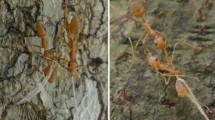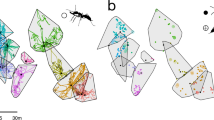Abstract
Many species of territorial animals are more aggressive toward strangers than neighbors, a pattern of aggression referred to as the ’dear-enemy phenomenon.’ In many cases, the mechanism by which neighbors are discriminated from strangers and the function of neighbor-stranger discrimination remain controversial. We investigated the spatial patterns of inter-colony aggression within and between two Pheidole species of seed-harvesting ants in the Mojave Desert of California by quantifying aggression between colonies in standardized staged encounters. We also tested whether the level of fighting between workers of two colonies is affected by previous exposure to each other. We show that neighbors (i.e., colonies less that 2.6 m away) of either species are treated less aggressively than more distant colonies and that habituation may be a mechanism by which this discrimination is achieved. The variation in aggression among spatially distant colonies also suggests that additional genetic or environmental factors are involved in recognition. The function of the dear-enemy phenomenon in these ant species may be related to the greater risk to the resources of a colony presented by strange workers than workers from a neighboring colony.
Similar content being viewed by others
Author information
Authors and Affiliations
Additional information
Received: 18 November 1999 / Received in revised form: 3 April 2000 / Accepted: 3 May 2000
Rights and permissions
About this article
Cite this article
Langen, T., Tripet, F. & Nonacs, P. The red and the black: habituation and the dear-enemy phenomenon in two desert Pheidole ants. Behav Ecol Sociobiol 48, 285–292 (2000). https://doi.org/10.1007/s002650000223
Issue Date:
DOI: https://doi.org/10.1007/s002650000223




